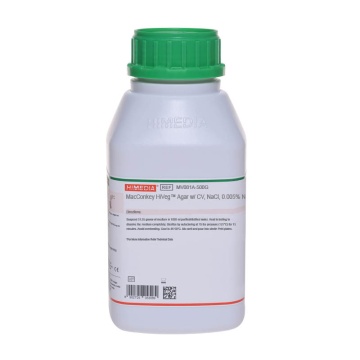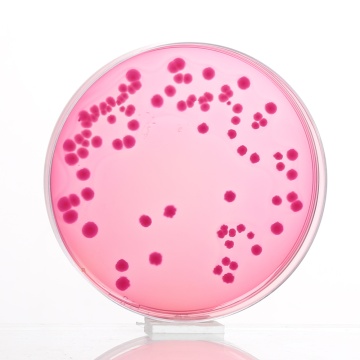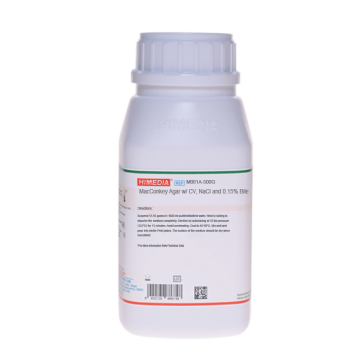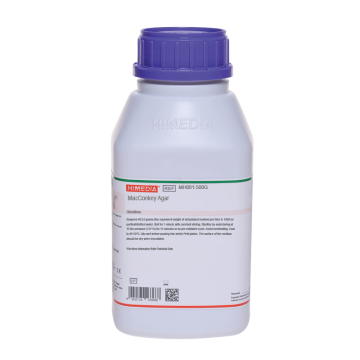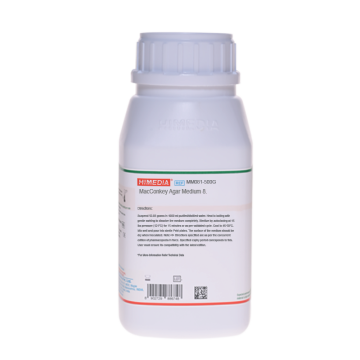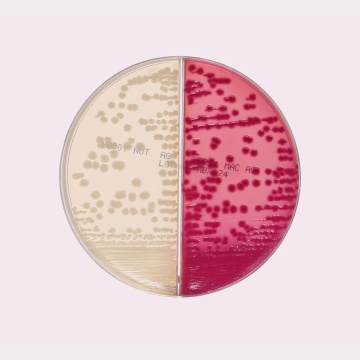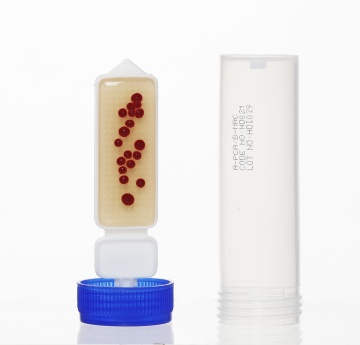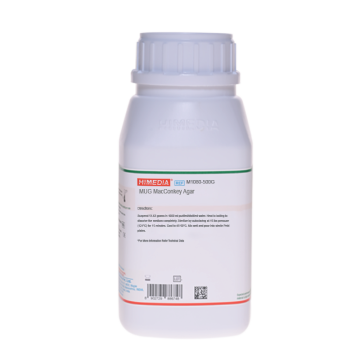 Your enquiry has been submitted
Your enquiry has been submitted
MacConkey Agar w/ 0.15% Bile Salts, CV and NaCl
Coliforms#CC293D
For the selective isolation and differentiation of coliform organisms and other enteric pathogens from clinical and non clinical samples.
Composition
| Ingredients | g/L |
|---|---|
| Gelatin peptone | 17.000 |
| Tryptone | 1.500 |
| Peptone | 1.500 |
| Lactose | 10.000 |
| Bile salts | 1.500 |
| Sodium chloride | 5.000 |
| Neutral red | 0.030 |
| Crystal violet | 0.001 |
| Agar | 15.000 |
Final pH (at 25°C): 7.1±0.2
**Formula adjusted, standardized to suit performance parameters
Directions
Suspend 51.53 grams in 1000 ml purified/distilled water. Heat to boiling with gentle swirling to dissolve the agar completely. Sterilize by autoclaving at 15 lbs pressure (121°C) for 15 minutes. Avoid overheating. Cool to 45-50°C. Mix well and pour into sterile Petri plates. The surface of the medium should be dry when inoculated.
Principle And Interpretation
MacConkey agars are slightly selective and differential plating media mainly used for the detection and isolation of gram-negative organisms from clinical (1), dairy (2), food (3,4), water (5), pharmaceutical (6,7) and industrial sources (8). It is also recommended for the selection and recovery of the Enterobacteriaceae and related enteric gram-negative bacilli. USP recommends this medium for use in the performance of Microbial Limit Tests (7).
These agar media are selective since the concentration of bile salts, which inhibit gram-positive microorganisms, is low in comparison with other enteric plating media. The medium M081, which corresponds with, that recommended by APHA can be used for the direct plating of water samples for coliform bacilli, for the examination of food samples for food poisoning organisms (4) and for the isolation of Salmonella and Shigella species in cheese (2). Other than that this medium is also used for count of coli-aerogenes bacteria in cattle and sheep faeces (9), the count of coli-aerogenes and non-lactose fermenters in poultry carcasses (9), bacterial counts on irradiated canned minced chicken (10) and the recognition of coli-aerogenes bacteria during investigations on the genus Aeromonas (11,12).
MacConkey Agar is the earliest selective and differential medium for cultivation of enteric microorganisms from a variety of clinical specimens (13,14). The original medium contains protein, bile salts, sodium chloride and two dyes. The selective action of this medium is attributed to crystal violet and bile salts, which are inhibitory to most species of gram-positive bacteria. Gram-negative bacteria usually grow well on the medium and are differentiated by their ability to ferment lactose. Lactose-fermenting strains grow as red or pink colonies and may be surrounded by a zone of acid precipitated bile. The red colour is due to production of acid from lactose, absorption of neutral red and a subsequent colour change of the dye when the pH of medium falls below 6.8. Lactose non-fermenting strains, such as Shigella and Salmonella are colourless, transparent and typically do not alter appearance of the medium.
Peptone, Tryptone and gelatin peptone are sources of nitrogen, carbon, long chain amino acids and other nutrients. Lactose is a fermentable carbohydrate, Sodium chloride maintains the osmotic equilibrium. Bile salts and crystal violet are selective agents that inhibit growth of gram-positive organisms. Neutral red is the pH indicator dye.
Type of specimen
Clinical - faeces, urine etc., foodstuffs and dairy samples, water samples
Specimen Collection and Handling
For clinical samples follow appropriate techniques for handling specimens as per established guidelines (1,15).
For food and dairy samples, follow appropriate techniques for sample collection and processing as per guidelines (2,4).
For water samples, follow appropriate techniques for sample collection, processing as per guidelines and local standards (5).
After use, contaminated materials must be sterilized by autoclaving before discarding.
Warning and Precautions
In Vitro diagnostic use. For professional use only. Read the label before opening the container. Wear protective gloves/ protective clothing/eye protection/face protection. Follow good microbiological lab practices while handling clinical specimens and culture. Standard precautions as per established guidelines should be followed while handling clinical specimens. Safety guidelines may be referred in individual safety data sheets.
Limitations
- Though the medium is recommended for selective isolation, further biochemical and serological testing must be carried out for further confirmation.
- The surface of the medium should be dry when inoculated.
- Individual organisms differ in their growth requirement and may show variable growth patterns on the medium.
- Each lot of the medium has been tested for the organisms specified on the COA. It is recommended to users to validate the medium for any specific microorganism other than mentioned in the COA based on the user's unique requirement.
Performance and Evaluation
Performance of the medium is expected when used as per the direction on the label within the expiry period when stored at recommended temperature.
Quality Control
Appearance Light yellow to pink homogeneous free flowing powder
Gelling Firm comparable with 1.5% Agar gel.
Colour and Clarity of prepared medium Red with purplish tinge coloured clear to slightly opalescent gel forms in Petri plates.
Reaction Reaction of 5.15% w/v aqueous solution at 25°C. pH: 7.1±0.2
pH 6.90-7.30
Cultural Response
Cultural response was observed after an incubation at 30-35°C for 18-72 hours. Recovery rate is considered as 100% for bacteria growth on Soybean Casein Digest Agar.
| Organism | Inoculum (CFU) | Growth | Recovery | Colour of colony |
|---|---|---|---|---|
| Corynebacterium diphtheriae type gravis | >=104 | inhibited | 0% | |
| Shigella flexneri ATCC 12022 (00126*) | 50-100 | fair to good | 30-40% | colourless |
| Salmonella Paratyphi A ATCC 9150 | 50-100 | luxuriant | >=50% | colourless |
| Salmonella Abony NCTC 6017 (00029*) | 50-100 | luxuriant | >=50% | colourless |
| ## Proteus hauseri ATCC 13315 | 50-100 | luxuriant | >=50% | colourless |
| Salmonella Typhi ATCC 6539 | 50-100 | luxuriant | >=50% | colourless |
| Staphylococcus epidermidis ATCC 12228 (00036*) | >=104 | inhibited | 0% | |
| Escherichia coli ATCC 8739 (00012*) | 50-100 | luxuriant | >=50% | pink-red with bile precipitate |
| Staphylococcus aureus subsp.aureus ATCC 6538 (00032*) | >=104 | inhibited | 0% | |
| Salmonella Paratyphi B ATCC 8759 | 50-100 | luxuriant | >=50% | colourless |
| Escherichia coli ATCC 25922 (00013*) | 50-100 | luxuriant | >=50% | pink to red with bile precipitate |
| # Klebsiella aerogenes ATCC 13048 (00175*) | 50-100 | luxuriant | >=50% | pink to red |
| Salmonella Typhimurium ATCC 14028 (00031*) | 50-100 | luxuriant | >=50% | colourless |
| Enterococcus faecalis ATCC 29212 (00087*) | 50-100 | none - poor | <=10% | colourless to pale pink |
| Salmonella Enteritidis ATCC 13076 (00030*) | 50-100 | luxuriant | >=50% | colourless |
| Staphylococcus aureus subsp.aureus ATCC 25923 (00034*) | >=104 | inhibited | 0% |
Key :- * Corresponding WDCM numbers, # Formerly known as Enterobacter aerogenes, ## Formerly known as Proteus vulgaris.
Storage and Shelf Life
Store between 10-30°C in a tightly closed container and the prepared medium at 20-30°C. Use before expiry date on the label. On opening, product should be properly stored dry, after tightly capping the bottle in order to prevent lump formation due to the hygroscopic nature of the product. Improper storage of the product may lead to lump formation. Store in dry ventilated area protected from extremes of temperature and sources of ignition Seal the container tightly after use. Product performance is best if used within stated expiry period.
Disposal
User must ensure safe disposal by autoclaving and/or incineration of used or unusable preparations of this product. Follow established laboratory procedures in disposing of infectious materials and material that comes into contact with clinical sample must be decontaminated and disposed of in accordance with current laboratory techniques (1,15).
Reference
- Murray P. R, Baron E, J., Jorgensen J. H., Pfaller M. A., Yolken R. H., (Eds.), 8th Ed., 2003, Manual of Clinical Microbiology, ASM, Washington, D.C.
- Wehr H. M. and Frank J. H., 2004, Standard Methods for the Microbiological Examination of Dairy Products, 17th Ed., APHA Inc., Washington, D.C.
- FDA Bacteriological Analytical Manual, 2005, 18th Ed., AOAC, Washington, D.C.
- Salfinger Y., and Tortorello M.L. Fifth (Ed.), 2015, Compendium of Methods for the Microbiological Examination of Foods, 5th Ed., American Public Health Association, Washington, D.C.
- Lipps WC, Braun-Howland EB, Baxter TE, eds. Standard methods for the Examination of Water and Wastewater, 24th ed. Washington DC:APHA Press; 2023.
- British Pharmacopoeia, 2019, The Stationery office British Pharmacopoeia.
- The United States Pharmacopoeia, 2018, The United States Pharmacopeial Convention, Rockville, M.D.
- Williams, (Ed.), 2005, Official Methods of Analysis of the Association of Official Analytical Chemists, 19th Ed., AOAC, Washington, D.C
- Medrek T. F and Barnes Ella M., 1962, J. Appl. Bacteriol., 25(2),159-168.
- Thornley Margaret J., 1957, J. Appl. Bacteriol., 20(2), 273-285.
- Barnes Ella M. and Shrimpton D. H., 1957, J. Appl. Bacteriol., 20(2),273-285.
- Eddy B. P., 1960, J. Appl. Bacteriol., 23(2).216-249.
- MacConkey A., 1905, J. Hyg., 5:333.
- MacConkey A., 1900, The Lancet, ii:20.
- Isenberg, H.D. Clinical Microbiology Procedures Handbook 2nd Edition.
| Product Name | MacConkey Agar w/ 0.15% Bile Salts, CV and NaCl |
|---|---|
| SKU | M081 |
| Product Type | Regular |
| Physical Form | Powder |
| Origin | Animal |
| Packaging type | HDPE |
| References | 1.Murray P. R, Baron E, J., Jorgensen J. H., Pfaller M. A., Yolken R. H., (Eds.), 8th Ed., 2003, Manual of Clinical Microbiology,ASM, Washington, D.C. 2.Wehr H. M. and Frank J. H., 2004, Standard Methods for the Microbiological Examination of Dairy Products, 17th Ed.,APHA Inc., Washington, D.C. 3.Salfinger Y., and Tortorello M.L. Fifth (Ed.), 2015, Compendium of Methods for the Microbiological Examination ofFoods, 5th Ed., American Public Health Association, Washington, D.C. 4.FDA Bacteriological Analytical Manual, 2005, 18th Ed., AOAC, Washington, D.C. 5.Baird R.B., Eaton A.D., and Rice E.W., (Eds.), 2015, Standard Methods for the Examination of Water andWastewater, 23rd ed., APHA, Washington, D.C. 6.The United States Pharmacopoeia, 2018, The United States Pharmacopeial Convention, Rockville, M.D. 7.Williams, (Ed.), 2005, Official Methods of Analysis of the Association of Official Analytical Chemists, 19th Ed., AOAC,Washington, D.C8.Medrek T. F and Barnes Ella M., 1962, J. Appl. Bacteriol., 25(2),159-1689.Barnes Ella M. and Shrimpton D. H., 1957, J. Appl. Bacteriol., 20(2),273-285.10.Thornley Margaret J., 1957, J. Appl. Bacteriol., 20(2), 273-285. 11.Eddy B. P., 1960, J. Appl. Bacteriol., 23(2).216-249. 12.MacConkey A., 1905, J. Hyg., 5:333. 13.MacConkey A., 1900, The Lancet, ii:20. 14.British Pharmacopoeia, 2016, The Stationery office British Pharmacopoeia.1 5.Isenberg, H.D. Clinical Microbiology Procedures Handb0ook. 2nd Edition |
| Customized Product Available | No |






